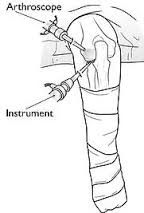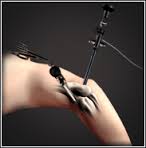

An elbow arthroscopy is a type of ‘keyhole’ surgery that allows the surgeon to look inside the hinged joint of the elbow using a small camera called an arthroscope. The arthroscope allows us to see what is causing the stiffness in your elbow. During the surgery, the arthroscope is placed into the elbow joint through a small cut in the skin, allowing the relevant structures to be inspected. Any loose bits of cartilage or bone found are removed. The thickened capsule is divided to allow for more movement of the joint. This is known as a capsular release. Scar tissue is also divided to allow for an increase in the elbow’s range of movement.


The elbow is a hinge joint that, when damaged, can become stiff in its movement.
Sometimes intra-articular damage can occur. This is damage from within the joint, for examplefollowing excessive stress on the joint, as in strenuous exercise, or as a result of medicalconditions such as arthritis. This type of damage can cause bits of cartilage or bone to becomeloose within the joint and interfere with the normal range of movement of the elbow.
Pain due to overuse or inflammation of lateral side of elbow known as ‘Tennis Elbow’ also needs an Arthroscopy in which the diseased part of the muscle-tendon and bone is cleaned off the bad tissue.
An injury or arthritis can damage the ends of the bones and cause bone spurs to develop. These spurs can be painful and make it hard to move the elbow. The doctor can remove the spurs by using special tools, such as a burr, inserted into the joint through the portals or small incisions. After the spurs are removed, the elbow moves more easily and with less pain.
Alternatively, extra-articular damage can occur. This is damage from outside the joint, and canbe caused by a number of factors including trauma and previous elbow surgery. This usuallyresults in scar tissue formation and thickening of the capsule surrounding the elbow joint,which restricts the movement of the elbow.
The need for surgery is dependent on the amount of disability and discomfort you suffer as aresult of your condition. Elbow arthroscopy is just one possible treatment for this condition.Other options include physiotherapy, which may be trialled first to help improve the range ofmovement.
It is important to remove all jewellery on the affected arm in preparation for the surgery. Youwill also need to fast (have nothing to eat or drink) from midnight the day before your surgery.
The pre-assessment team will discuss with you which of your medications (if you are takingany) can be taken on the day.
The anaesthetist will review your fitness for surgery and finalise the planned anaesthetic
regime. You will then go into the operating theatre for your operation under general
anaesthetic.
The surgery involves making several cuts around the elbow so that the arthroscope can
access the elbow joint. After assessing the structures that make up the joint, any loose bits ofbone or cartilage are removed and the thickened capsule around the elbow joint is divided.
The surgeon will assess the extent of the motion you have throughout the procedure. At theend of the operation, your skin wounds are stitched and dressed with sterile dressing. You mayalso be given a sling.
Post-operative pain is normal and you will receive a combination of pain-relieving methods tohelp minimise this pain.
The elbow may feel stiff during the first few days following your operation, but this shouldgradually improve. If you have been given physiotherapy exercises it is important to continuewith these while you are at home so as to avoid the risk of the elbow remaining stiff andreducing the potential benefits of the surgery. It is also important to move your shoulder, wristand fingers regularly to prevent these joints from stiffening up.
You should leave the dressing intact, clean and dry until your next follow-up appointment,about two weeks after your surgery. It is essential that you maintain an adequate level of pain relief after your surgery, so pleasemake sure that you regularly take your prescribed painkillers. Depending on the nature of your work, you may be signed off from working for between oneand three weeks.
Two weeks after surgery you will come to the hospital to have your wound checked and stitches removed.